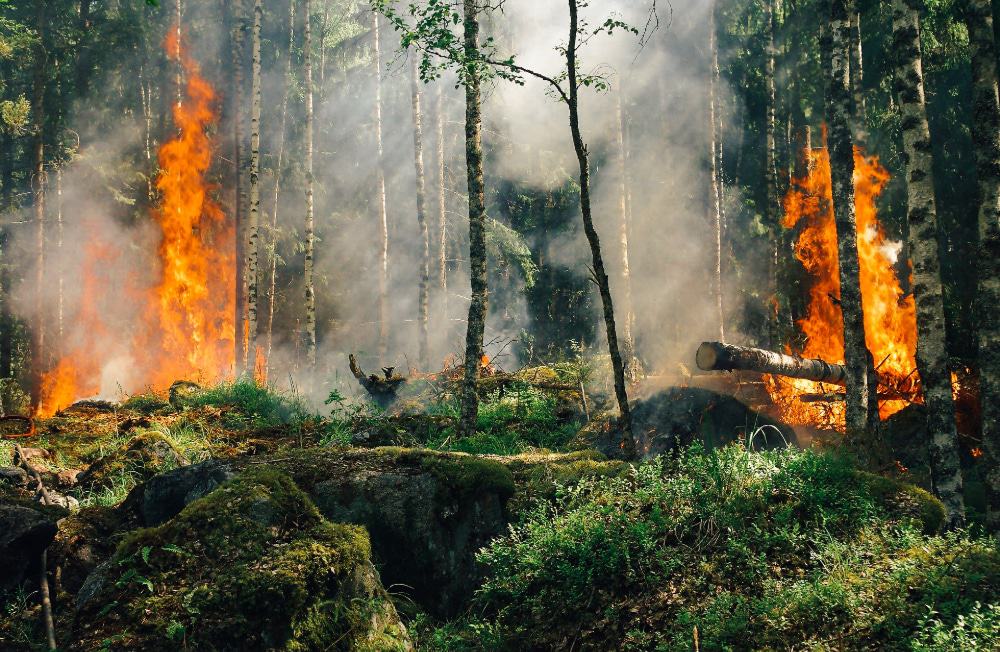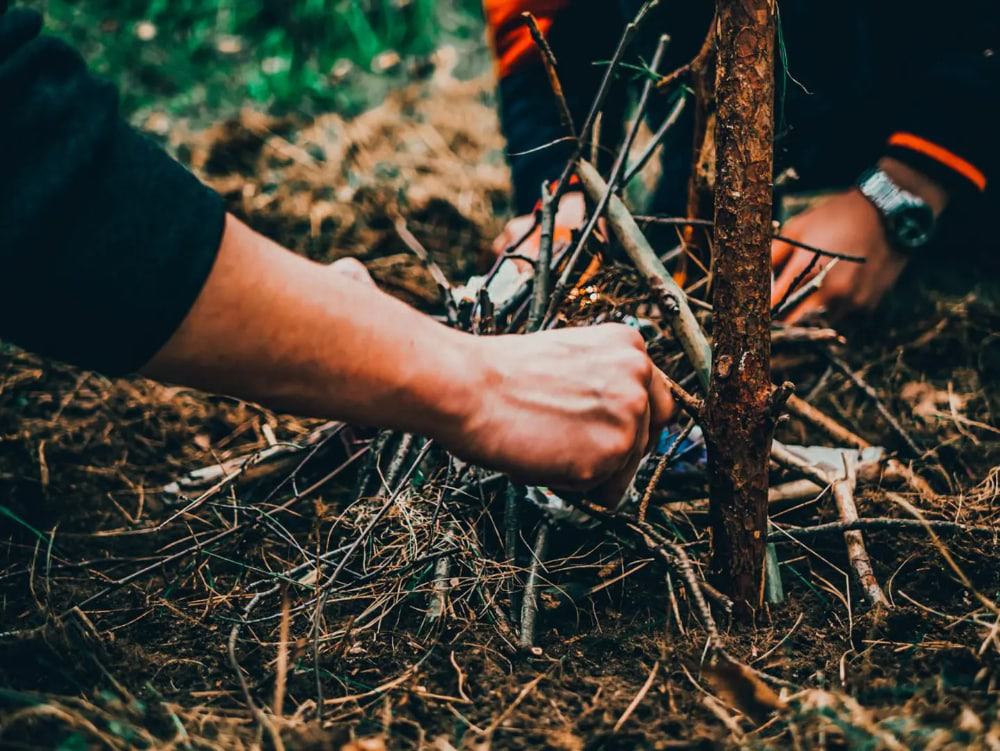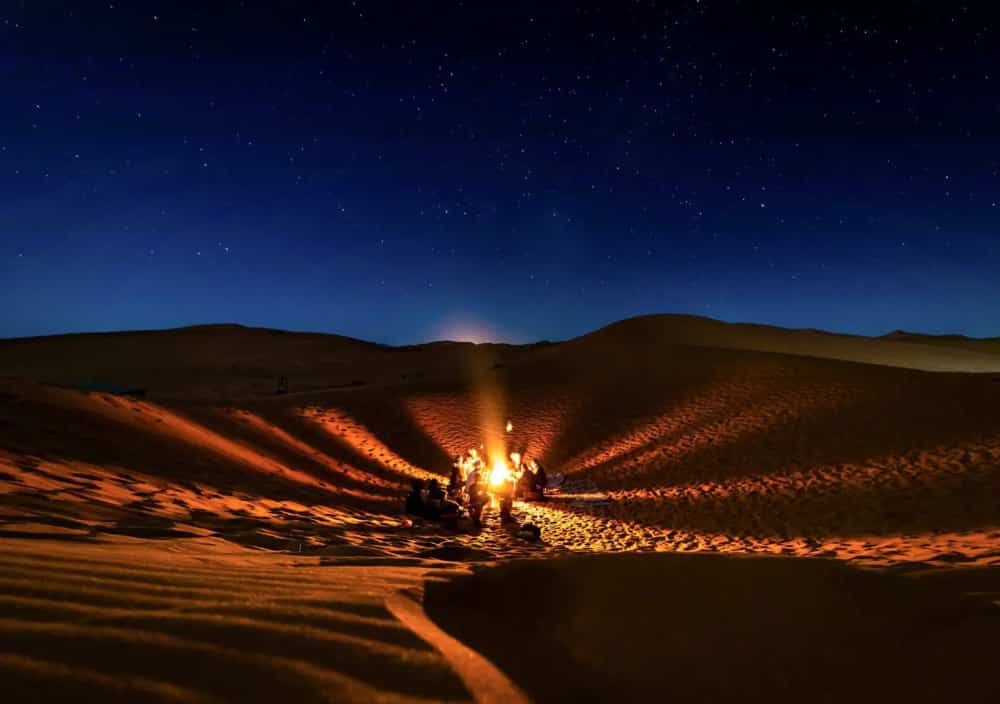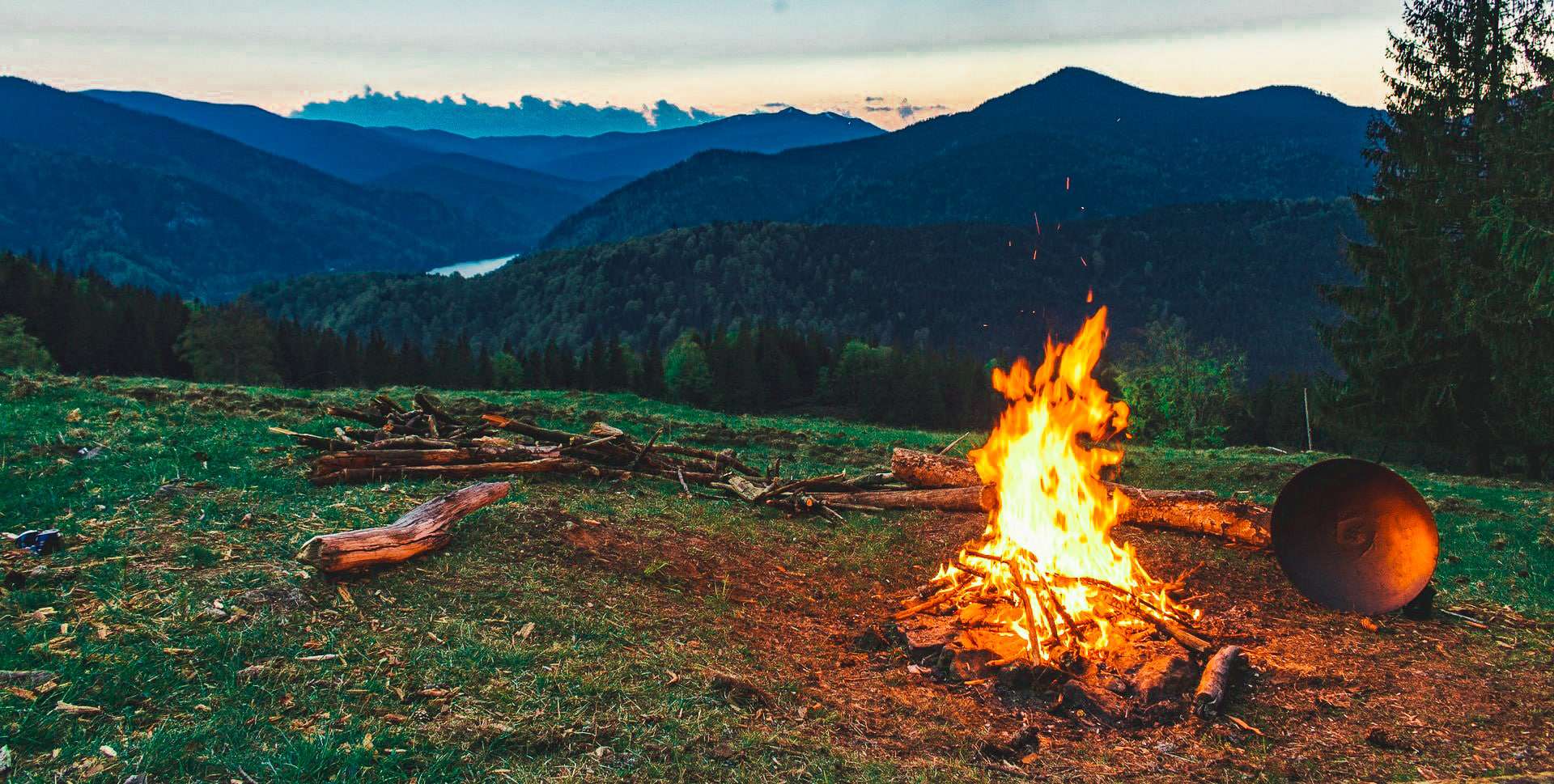The campfire plays an important role in enjoying an outdoor adventure. It provides warmth, a place to cook and a place to tell stories. It is very much the centerpiece of any camping trip.
In this article, I’ll explain which type of campfire to build for different circumstances. I’ll show you how to start a campfire. And I’ll show you how to build it without accidentally starting a forest fire [1].

Related: Want to stay cosy in your tent? Consider picking up a canvas tent for proper insulation. Check out our review of the top cotton canvas tents.
Read on to learn how to build a campfire!
Preparing the Fire Bed
The first step is to build a fire bed. A strong foundation to your campfire is crucial for both a good fire and for safety.
You should always use an existing fire bed when possible. For starters, these are often already constructed with safety in mind. But campfires can also sterilize healthy soil and affect the visual appeal of an area.
If you need to build a campfire, you will first need to clear a small area. You should then set large rocks around the fire bed for insulation. To help protect the soil from permanent damage, you can build a platform of soil around 3-5 inches high. Always remember to dismantle a new campfire when finished with it.
Fire bed safety
There are a few crucial safety checks when you’re setting up a campfire.
First, you should only build fires where they are permitted. In campgrounds, there are often designated areas set as fire pits. Each National Park has its own rules on allowing campfires. The National Park Service recommends that you contact the park or visitor centre [2] in advance of your trip. Be aware that in some places fires are banned during the dry season to avoid forest fires.
Second, you should always clear the area of any flammable materials. You should clear the area up to 8-10 feet around the fire. While this may seem a large distance, a gust of wind can fan a fire over a large area. Flammable materials include bushes, plants, fallen branches, dead grass, leaves, and tents.
Related: Expecting high winds? Check out our review of the best tent for wind.

Tip: Make sure your campfire is a safe distance from your camp – at least 20 feet but if possible aim for 200 feet in bear country to avoid attracting any unwelcome guests to your campsite!
Gathering Wood
There are three types of wood you will need – tinder, kindling and firewood.
- Tinder is used in starting a fire and includes anything that produces a flame easily. This can be fire starters, wood shavings, dry leaves, dried moss, balled up paper or pieces of cardboard. In Scotland, we’re blessed with having heather [3]. This creates beautiful valleys full of pink and, as it dries, provides the perfect fire starter.
- Once you have a small flame going, the kindling helps build it into a bigger fire. Kindling includes small twigs or branches around the size of a finger.
- With a small fire going, the firewood is then used to create a long-lasting fire. Firewood includes any wood ranging from the size of two fingers up to the size of your forearm. You should avoid taking pieces bigger than this as these rarely burn through and can leave a mess.
Where to find wood
In campgrounds
In campgrounds, you should buy firewood from the campground hosts or locally. You should avoid picking up dead branches as this can strip the area of natural beauty.
If you’re travelling far, It’s also advised that you shouldn’t bring wood with you. This is because you may harm the local area with any infectious diseases or insects the firewood may bring.
In the backcountry
In the wild, you can find wood by foraging for dead, fallen branches on the ground.
It’s generally advised that you shouldn’t cut wood from trees, even if they are dead. Trees are vital to local ecosystems and an area’s natural appearance.
What to look for in firewood
The best fires always rely on dry wood. The dryer the wood, the easier it is to get the fire started and the less smoke it produces.
An easy way to check whether the wood is dry is to try breaking it in half. If it bends, it’s either wet or is not yet dead. Dry wood should always break easily and feel brittle to the touch.
Some wood can contain chemicals that can be harmful if burned. For instance, some pallets are coated with toxic chemicals.
Building the Campfire
Choosing the right type of fire
Choosing a type of campfire to build is important. Some fires are much more useful than others in specific situations.
There are several types of campfires:
- A Teepee is the classic campfire that we all know and love. It’s perfect for storytelling or toasting marshmallows. It’s also useful when your bulky firewood is a bit damp, as you have an opportunity to dry it out before laying it.
- The Log-cabin is a long-lasting fire with a wide flat structure that makes it perfect for cooking. Bear in mind that it takes a while to collapse. This will mean waiting a little longer before the cooking can begin
- The Lean-to is perfect for a windy day as the firewood acts as a windshield as you get your first flames going.
I would recommend the Teepee or Lean-to fire to beginners. The Log-cabin requires a slightly more complex structure.
Building a Teepee campfire
- Place a small amount of tinder in the center of your pit – if you have bark handy, you can use a piece to hold your tinder.
- Stack kindling around this in the shape of a teepee tent.
- You can add larger logs around this structure in a similar teepee shape.
Bear in mind that the Teepee produces a lot of heat and burns fast, so you might need more wood than expected.
Building a Log-cabin (parallel) campfire
- Put plenty of tinder in the center, forming a small teepee-shape.
- Place two pieces of firewood logs parallel to each other with a big gap in the middle.
- Then place another two pieces on top, at right angles.
- You can add other levels as needed.
- Light the tinder and maintain the fire by feeding wood through the sides of the cabin.
The log-cabin should look somewhat like Jenga with all the center blocks removed. A great advantage of this method it doesn’t matter if the larger logs are wet, they will dry out as the fire burns.
Building a Lean-to campfire
- Push a long piece of wood into the ground at an angle.
- Then lean smaller pieces of kindling against the longer piece.
- Put tinder beneath this.
- Light the fire and continue to add tinder and kindling to keep it burning.
Lighting the Fire
There are several tools you can use to light the fire. These could be matches, a lighter, or a BBQ lighter. I’d always recommend carrying some waterproof matches with you, as a precaution.
Tip: Always bring more than one fire-starting tool with you – you never know when you might need a backup!
You can then light the tinder. Once a flame has caught, blow very gently on the bottom of the fire. This helps feed the fire with oxygen and grows the flame bigger.
You can continue to build the size of the fire using your kindling. Once you have a small fire going, you can start adding firewood. This will help turn it into a long-burning fire that requires little maintenance.
Beware of adding firewood too early. This can smother the fire and could extinguish any flame.
There are a few camper tips if you’re struggling to get a flame going. The first is using a few cotton balls soaked in kitchen oil in the tinder. These will catch easily and create a good amount of heat fast. Another tip is to bring firelights with you.
No matches?
If you find yourself having to start a fire without matches, the easiest alternative I recommend is using a glass lens to start a fire.
Simply place your tinder on the ground or with your kindling and align the beam of the sun to the tinder. When it starts to smoke, blow gently to help produce a flame. This method is great but is only reliable in sunny weather.
The hardest method is the primitive use of friction to light the fire. Make a v-shaped notch into a log or piece of firewood place bark underneath the notch to catch an ember as you spin the slender spindle in the v-shaped notch.
Keep going until an ember is formed, then use that to catch your tinder and start your fire.
Related: We’ve looked at dozens of tents to see how they stack up in winter camping. Find out what the best four season winter tent is.
Bring homemade firestarters
Crumpled up paper products like tissues, newspapers, toilet paper, and possibly even book pages (useful if either the situation or the book is dire) are all great firestarters often handy to campers.
Dryer lint and wood shavings can be good firestarters as well, so maybe start saving them in a jar to take on your next camping trip.
Greasy chips and snacks like Doritos also make surprisingly good firestarters. Just try not to think too much about how quickly the oily, fatty snack burns up as you eat the rest of the pack…
Keeping the campfire burning
Once you have the fire built up, you just need to keep it going.
You can do this by adding wood as needed. But, you should avoid adding too much wood at once as this could smother the flame.
You should also bear in mind that you can’t remove wood once you add it. If you add too much, the flames could get too high and become dangerous. Generally, it’s a good idea to err on the side of caution with fires. You can always add more on if the fire is not big enough, but you can’t remove wood if it’s too big.
Cooking on the campfire
One of the great things about a campfire is being able to cook over it. Flames alone don’t mean that the fire is hot enough to cook over yet, so be patient and wait for a bed of glowing coals to form in the pit. This might take around 30 to 45 minutes depending on the weather.

Many foods will burn on the outside without cooking if you try and hold them over an open fire. Bringing a metal grill to rest over your campfire means you can boil water, roast meat, and grill vegetables much easier.
You can divide your fire in half, raking the glowing coals to one side and allowing the other to burn as an open flame. Placing a grill on top of this will give you different levels of heat to cook on, making cooking easier and better.
Putting out the Fire
One thing that can often surprise a beginner is the length of time it can take to fully extinguish a fire. You should set aside plenty of time for this as any remaining warmth in the firepit can start a fire.
Tip: Never leave a fire unattended until it is entirely extinguished
Water should be used to extinguish campfires. This can be done by sprinkling it onto the coals. You would want to avoid pouring a large amount of water over the firepit. A flooded fire pit will mean others can’t use it. If you’re in a campground, it’s always a good idea to check with the management to find out their policy on putting out fires.
When you put out a fire with water, be sure to stand well away from the steam. This is boiling and can cause burns if care is not taken.
Finally, the fire area must be completely cold before you leave. Any residual heat could easily ignite and cause a forest fire. A good test for this is to hold the back of your hand just above the ashes and see if you can feel any heat.
Cleaning Up
Everyone should be able to enjoy the outdoors. This means that we should all leave areas just as we found them. The Leave No Trace Principles [4] embody this idea and should be followed by all campers.
This includes reversing any changes you have made to the site. For example, deconstructing any campfires that you have built. And putting back any natural flammable materials that you cleared from the area. If you’re in the backcountry, bag any charcoal and scatter it around a wide area.
It also includes avoiding damaging any trees or plants. This means using either locally purchased wood or dead wood that has fallen to the ground for your campfire.
Sustainability of an area is important to maintaining its natural beauty. You should only build a campfire if you are in an area with plenty of wood. Some areas with fewer trees may not be able to keep up with the level of wood use required for campfires. You should also only burn trash if it can be fully consumed by the fire. Plastic, cans, foil, bottles and so on are not suitable for burning.
Finally, if you are unable to meet the principles then you could also consider using a stove instead of a campfire.
Safety and Etiquette
As mentioned earlier, you should always checks if campfires are permitted. The area around the fire should also be clear of any flammables.
It’s a good idea to keep fire safety equipment nearby. For instance, this could be a few gallons of water. If you are desperate, you can always break apart the coals and spread sand or dirt over the coals. But, be aware that this may insulate the coals rather than extinguish the fire risk.

Sometimes the group can also pose a risk. It’s important to look after any kids or pets around a fire. And adults should be wary of having a few too many drinks.
You should never use gasoline to light a fire. You should also not squirt lighter fluid onto a fire as the flames can travel up the stream.
Tip: Going camping in winter? Check out our guide to winter camping.
If you’re looking for a safety guide to print out, you can find a campfire safety checklist [5].
Wrapping It All Up
That’s all folks! You now know how to craft the perfect campfire for the right situation. The only thing now is to go outdoors and practice, practice, practice!
References
[1] https://www.pressherald.com/2020/07/08/illegal-campfire-sparks-freeport-forest-fire/
[2] https://www.nps.gov/articles/campfires.htm
[3] https://en.wikipedia.org/wiki/Calluna
[4] https://lnt.org/why/7-principles/
[5] https://smokeybear.com/prevention/SmokeyCampfireSafetyChecklist.pdf
